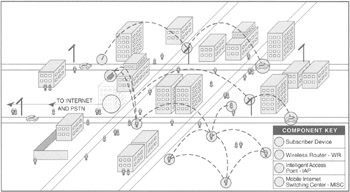Extending Range Via an Ad Hoc Peer-to-Peer Network
|
|
Ad hoc peer-to-peer technologies extend the maximum range of Wi-Fi networks from distances typically measured in hundreds of feet to several miles. The product adds multihopping peer-to-peer capabilities to off-the-shelf 802.11 cards.
Software is utilized to turn WLAN cards into router repeaters. The result is a system that enables users who are out of range of an AP to hop through one or more other nearby users until they connect to the AP. The software also automatically routes transmissions from congested APs to uncongested ones. Overall network performance is enhanced in addition to the dramatic increases in effective range. In addition, users within range of each other form a network, albeit without a connection to a larger network or the Internet.
Peer-to-peer mode is one part of the 802.11 standard. Most WLANs are operating in the infrastructure mode in which multiple users independently connect to APs. This method severely limits the useful range of the network, forcing network administrators to add multiple APs to create an extended coverage area. The software uses the peer-to-peer capabilities included in every 802.11 card to achieve increased network coverage by making all card users a potential part of the transmission network. Figure 3-6 illustrates an ad hoc peer-to-peer network.[9]

Figure 3-6: An ad hoc peer-to-peer network
Network Features and Products
Traditional wireless solutions typically attempt to create a mobile broadband network by overlaying some IP equipment onto a circuit-switched, voice-centric system. An ad hoc peer-to-peer network offers an end-to-end, IP-based, packet-switched, mesh architecture that mirrors the wired Internet's architecture and its resulting advantages. In peer-to-peer technology, the users are the network in that they add mobile routers and repeaters (or picocells) to the network infrastructure.
Because users carry much of the network with them, network capacity and coverage is dynamically shifted to accommodate changing user patterns. As people congregate and create pockets of high demand, they also create additional routes for each other, thus enabling access to network capacity through neighboring APs via multihopping. Users will automatically hop away from congested routes and APs to less congested routes and network APs. This permits the network to dynamically and automatically balance capacity and increase network utilization.
The Advantages of Ad Hoc Peer-to-Peer Networks
Ad hoc peer-to-peer networks offer a number of exciting advantages for new market entrants or municipally owned and operated networks. First, the permanent, fixed components such as APs and wireless routers are small and unobtrusive relative to the cell towers found in third-generation (3G) architectures. This provides the advantage of much less expensive deployment both in terms of physical plant and legal issues (leasing roof rights, for example). The time needed to deploy service in a given market is also greatly reduced.
Secondly, when enough subscriber devices are present in a given area, the reach of a network is instantly and inexpensively increased. By virtue of using a subscriber device as a router or repeater, the service provider is spared the expense of APs and wireless routers. Furthermore, a network is established among subscriber devices where there is no intelligent access point (IAP) or wireless router to connect the subscriber devices to the Internet or other networks.[10]
In ad hoc peer-to-peer mobile architecture, all nodes in the network, including subscriber devices, act as routers and repeaters for other subscribers in the network. This enables users to hop between any number of devices in the network to achieve the desired connection. As a result, user devices can also act as wireless routers. That is, they can act as routers and repeaters for other users. This increases network robustness while reducing infrastructure deployment costs. Ad hoc peer-to-peer networks make it easy for two people to directly share files, e-mail, music, video, or voice calls. Network infrastructure is not needed. Therefore, users can form high-speed voice and data networks anywhere, anytime. Instead of wireless operators subsidizing the cost of user devices (handsets, for example), users actually subsidize and help deploy the network for the operator.
The Components of Ad Hoc Peer-to-Peer Networks
The network is comprised of the following elements: subscriber devices (including personal digital assistants [PDAs], laptops, mobile phones, automobiles, and so on), wireless routers, and APs. Subscriber devices can be either mobile or fixed, whereas the remaining elements are fixed. Wireless routers and APs can be mounted on utility poles, billboards, buildings, or any other convenient structure. It is important to note that the transceiver and modem technology within a subscriber device is identical to the transceiver technology in the fixed infrastructure. This keeps subscriber and infrastructure costs exceptionally low.
[9]Matthew Peretz, "802.11 Coverage for Miles and Miles," 802.11-Planet.com, www.80211-planet.com/news/article/0,,1481_970641,00.html, February 7, 2002.
[10]"Corporate and Technology Overview," a white paper from MeshNetworks, www.meshnetworks.com/pdf/wp_corpoverview.pdf, 2002.
|
|
EAN: 2147483647
Pages: 96